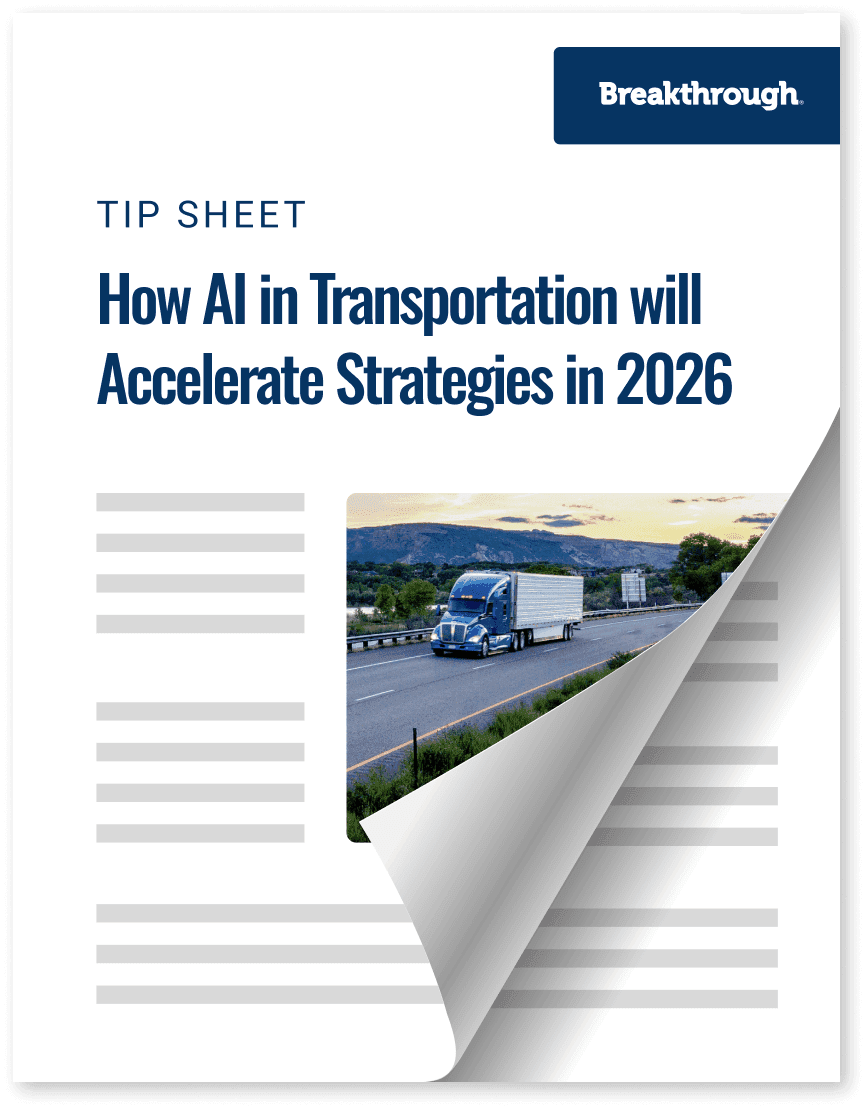How AI in Transportation will Accelerate Strategies in 2026

Trending
Top Posts
8 min read
February 3, 2021

Share:
Table of contents
Browse the table of contents to jump straight to the part you’re looking for
The pressure to sustainably move products to market continues to grow for shippers. Sustainability trends exist across many areas of the supply chain—from sustainably sourcing raw materials to offering more environmentally friendly or natural final products. Transportation emissions are no exception to this.

In 2016, the transportation sector surpassed power generation as the highest emitter of greenhouse gases (GHGs) in the United States. Within the transportation sector, emissions from medium- and heavy-duty vehicles have accounted for the most growth of transportation GHG emissions in the past decade.
Read more about how sustainability initiatives in transportation are evolving here.
This puts shippers in a position that could incite great advances in sustainability for major retailers, manufacturers, and other companies that ship goods. For shippers on Fuel Recovery, Breakthrough unlocks access to valuable data that we use to directly influence sustainability reporting, inform alternative fuel initiatives, and operationalize different strategic levers.
There are three major ways that an engagement with Breakthrough’s Fuel Recovery solution helps clients reduce their overall emissions:
For shippers looking to make improvements to transportation tailpipe emissions, they need to understand the intricacies of their unique fleet make up in its current state. This is best done by removing the distortions associated with traditional fuel reimbursement calculations.
Once that groundwork is laid they can better report which initiatives are driving more sustainable change. Breakthrough uses publicly available data to paint the most accurate picture of their carriers’ fuel efficiencies to create transparency around how much their freight is actually emitting when transported over the road.

And carrier fuel efficiencies are often not what shippers believe them to be. Truck manufacturers continually develop technologies that produce more efficient vehicles for their clients, despite the perception that commercial trucks are proverbially inefficient. These innovations produce roughly a 3 percent increase in fuel efficiency annually.
One factor that is important to consider is fleet age. Older vehicles rely on older technology, so fuel efficiency is in line with standards set years ago. As new tractors are introduced to the fleet, they are more likely to contain technologies that make them more efficient.

Most fuel efficiency gains come from improving the aerodynamics of the vehicle, advancing engine technology, and a higher level of vehicle autonomy. The 2019 Freightliner Cascadia (below) is an example of new aerodynamics and Level 2 Autonomy to gain fuel efficiency.

Another trend in commercial transportation is the increasing adoption of aftermarket products that drive fuel efficiency. Aftermarket products include trailer skirts and auto-inflation systems for tires for efficiency on the road but are also expanding to include anti-idle technology and auxiliary power units (APU) to limit fuel consumption when the vehicle is not in motion.

Fleets can more easily set engine parameters to ensure a truck operates in the most efficient manner for its duty cycle. The adoption of electronic logging devices (ELDs) has also brought fuel savings potential, including better monitoring of drivers’ impacts on fuel efficiency and better visibility for load planning. Lastly, the adoption of higher levels of autonomy can better optimize vehicle performance for efficiency.
Organizations like the North American Council for Freight Efficiency (NACFE) provide industry guidance for carriers about the dynamic technology landscape facing the trucking industry. Well-managed carriers will best increase their fuel efficiency by employing multiple technologies to best-fit the needs and characteristics of their fleets.
Breakthrough helps clients understand how their unique freight characteristics and currently available vehicle technologies impact the fuel efficiency of their network. As these new technologies and tractors are introduced to fleets, they will contribute to overall fleet efficiency, which is important to understand and account for in fuel reimbursements and reporting.
This provides more transparency into the emissions associated with the movement of goods and creates the opportunity for continuous improvement in a shipper’s for-hire or dedicated truckload network. As a strategic transportation partner, Breakthrough works to educate and empower our clients with both for-hire and private fleets to better understand their unique emissions footprint and identifies places to improve their fleet efficiencies and calculations.
Having a baseline understanding of truckload emissions is only part of the equation because most shippers have much more complex transportation networks. Rail makes up a significant portion of many shippers’ strategies, and this, too, can be a black box when it comes to accounting for and abating emissions.

Moving goods via rail can cut fuel consumption and emissions by over one-half compared to the same truckload shipment. Breakthrough Fuel Recovery accurately prices intermodal shipments to track the fuel consumption of both the over-the-road and rail sections of the journey. This enables more transparency to the price and environmental implications of intermodal freight, ultimately bringing full visibility of the benefits to shippers.
Beyond bringing accuracy and transparency to intermodal accounting, identifying modal conversion opportunities within each shippers’ network can introduce new emissions savings opportunities. When making intermodal recommendations, Breakthrough considers both the emissions benefit and the combined fuel and freight costs to ensure mode conversions meet a shipper’s sustainability goals and financial strategies.
Identifying modal conversions is on-going, because the nature of fuel and freight prices are volatile, and new opportunities emerge regularly. As major railroads adjust their strategies—as we currently see with the wide-spread adoption of Precision Scheduled Railroading (PSR)— complexity is added which brings value to Breakthrough’s ongoing research and continual access to a shipper’s network data.
Breakthrough’s support also extends beyond the modes of truckload and intermodal. Breakthrough’s Maritime Fuel Management offering brings visibility to the cost, consumption, and emissions of specific fuel types along specific trade lanes.
There is a growing push to replace fossil fuels with alternative solutions in transportation. The excitement and momentum behind technologies like battery-electric vehicles (BEVs) and hydrogen fuel cell electric vehicles (FCEVs) captures many headlines but make up less than one percent of overall commercial transportation energy consumption.
Breakthrough works with clients to provide unbiased, in-depth guidance to illustrate where shippers have opportunities to implement alternative energy options based on their unique network footprint (highlighted below). We can assist your team through alternative energy strategy identification, implementation process, and will help provide on-going program management through Breakthrough CleanMile.

Breakthrough has an established track record of implementing and managing shipper-led strategies for alternative fuels like compressed natural gas (CNG) and biodiesel. These programs accurately account for the emissions benefits of the lower-carbon fuels and capture incentives that improve the financial viability of these options. By aligning collaboration between shippers, carriers, and fuel providers, we have forged long-term strategic partnerships that continue to promote emissions-reducing objectives.
BEVs and FCEVs have a promising future across all duty cycles of transportation, although their applications today present their fair share of challenges. Breakthrough works with shippers to best understand the tradeoffs of these emerging technologies while creating realistic roadmaps for the piloting or commercialization of zero-emission vehicles (ZEVs). To provide better information about these strategies, Breakthrough’s team stays up to date on alternative technology developments—like the work being done by Nikola Motors—to keep shippers on the leading edge.
Breakthrough believes that a low-carbon future will also involve a shift in focus from tailpipe emissions to lifecycle emissions. This includes considerations for how energy is sourced and refined, on top of its emissions when used in the operation of a vehicle. For CNG vehicles, this means tracking whether the natural gas is derived from fossil fuels or if it was made from renewable sources (like landfills or dairy waste).
For emerging technologies like BEVs—which have no tailpipe emissions—it will require tracking where the electricity was created – for example from renewable energy sources like wind or water or from a fossil fuel like coal. Breakthrough brings tailpipe and lifecycle considerations into the alternative fuel strategies of shippers. Ultimately, this allows for better tracking of overall energy emissions and the potential to capitalize on carbon credits or incentives for making low-carbon choices.

Breakthrough is committed to helping shippers reduce the cost, consumption, and emissions of moving goods to market on the operational side, but are proud to provide ongoing advisement services to help our clients understand their unique network realities. The emissions component of this commitment will continue to evolve, but as we continue to develop solutions for the marketplace, Breakthrough shippers will reap the benefits of our underlying organizational principles: to remove distortion, create transparency, and establish fairness in their transportation network.
While these principles relate to their fuel accounting and freight optimizations, it extends to accurately accounting commercial vehicle efficiencies, modal conversion optimization, shipper-led alternative energy strategies, and beyond.

8 min read
December 23, 2025
Navigate fuel surcharge rates with our expert guide. Discover how to calculate fair reimbursements and overcome the limits of traditional fuel surcharge models.
Read more
5 min read
December 16, 2025
Explore the draft V2.0 SBTi corporate net-zero standard. Learn about new guidance on biofuels, EACs, and scope 1 and 3 emissions to reach net-zero by 2050.
Read more
8 min read
December 10, 2025
Learn how DOE fuel surcharges work, their limitations, and how market-based fuel reimbursement strategies improve cost accuracy in freight.
Read more